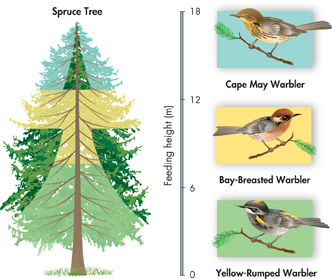The Competitive Exclusion Principle Direct competition between different species almost always produces a winner and a loser—and the losing species dies out. One series of experiments demonstrated this using two species of single-celled organisms. When the species were grown in separate cultures under the same conditions, each survived, as shown in Figure 4–6. But when both species were grown together in the same culture, one species outcompeted the other. The less competitive species did not survive.
Experiments like this one, along with observations in nature, led to the discovery of an important ecological rule. The competitive exclusion principle states that no two species can occupy exactly the same niche in exactly the same habitat at exactly the same time. If two species attempt to occupy the same niche, one species will be better at competing for limited resources and will eventually exclude the other species. As a result, if we look at natural communities, we rarely find species whose niches overlap significantly.

FIGURE 4–6 Competitive Exclusion The two species of paramecia P. aurelia and P. caudatum have similar requirements. When grown in cultures separately (dashed lines), both populations grow quickly and then level off. When grown together under certain conditions (solid lines), however, P. aurelia outcompetes P. caudatum and drives it to extinction.
dDividing Resources Instead of competing for similar resources, species usually divide them. For instance, the three species of North American warblers shown in Figure 4–7 all live in the same trees and feed on insects. But one species feeds on high branches, another feeds on low branches, and another feeds in the middle. The resources utilized by these species are similar yet different. Therefore, each species has its own niche. This division of resources was likely brought about by past competition among the birds.  By causing species to divide resources, competition helps determine the number and kinds of species in a community and the niche each species occupies.
By causing species to divide resources, competition helps determine the number and kinds of species in a community and the niche each species occupies.

FIGURE 4–7 Resource Sharing Each of these warbler species has a different niche in its spruce tree habitat. By feeding in different areas of the tree, the birds avoid competing directly with one another for food. Infer What would happen if two of the warbler species tried to occupy the same niche in the same tree at the same time?
dTable of Contents
- Formulas and Equations
- Applying Formulas and Equations
- Mean, Median, and Mode
- Estimation
- Using Measurements in Calculations
- Effects of Measurement Errors
- Accuracy
- Precision
- Comparing Accuracy and Precision
- Significant Figures
- Calculating With Significant Figures
- Scientific Notation
- Calculating With Scientific Notation
- Dimensional Analysis
- Applying Dimensional Analysis




